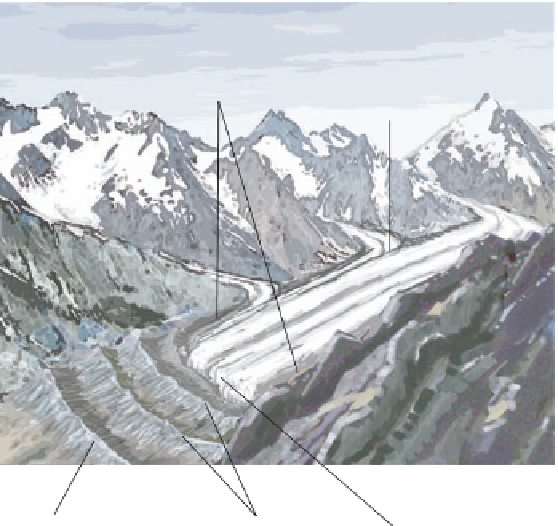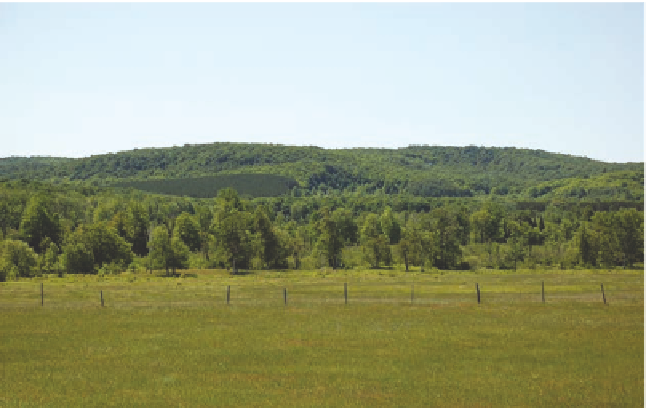Geoscience Reference
In-Depth Information
Another form of glacial till is
ablation till
, which is sedi-
ment that is carried within or on top of the ice and deposited
when the glacier melts. Ablation till usually contains coarser
fragments such as boulders because they are not crushed at the
base of the glacier. As a result, ablation till tends to be even less
well sorted than basal till.
Deposition of glacial till can result in very distinctive land-
forms. A notable type of till landform is a
moraine
, which is a
winding ridge-like feature that forms at the front or side of a gla-
cier, or between two glaciers. A glacial moraine is a very poorly
sorted deposit, ranging from clays to boulders, that appears
when sediments are brought forward by the conveyor action
within a glacier until they are dropped out of it (Figure 17.21).
A well-developed moraine forms only when the ice front or side
is stationary for a relatively long period of time. Only then can
the persistent internal motion of the ice continually bring forth
enough sediment for a visible ridge to grow.
The specific classification of any given moraine depends
on its spatial relationship to the glacier that deposited its till.
Figure 17.22 shows examples of the different kinds of mo-
raines. A
lateral moraine
forms on the edge of a glacier and is
usually best expressed along the sides of alpine glacial troughs.
When a lateral moraine is sandwiched between two glaciers,
it is called a
medial
moraine
. A
terminal moraine
(also called
an
end
moraine
) forms at the front of the ice and marks the
long-term stationary position at the farthest advance of a gla-
cier. Another type of moraine that forms at the ice front is a
recessional moraine
. Although a recessional moraine may look
exactly the same as a terminal moraine, it marks a pause in the
Stationary
glacial front
Sediment moves
within glacier
Buildup of glacial
till deposits
Figure 17.21 Formation of a moraine.
A moraine forms when
the position of the ice front is stationary for a long period of time.
This stationary position allows till to be deposited in one place
due to the conveyor-like action within the interior of a glacier.
overall retreat of the ice, rather than the farthest advance. A final
kind of moraine is called
ground moraine
. This kind of moraine
forms when the retreat of the ice is slow but steady, allowing an
irregular pattern of deposition that creates a hummocky land-
scape consisting of small hills and depressions (Figure 17.23).
Moraine
A winding ridge-like feature that forms at the front
or side of a glacier or between two glaciers.
Lateral
moraines
Medial
moraines
(b)
Figure 17.22 Types of moraines.
(a) Lateral, medial, and end mo-
raines in an alpine glacier system. (b) The hill in the background is a
portion of the Port Huron moraine in northwestern Lower Michigan. This
moraine can be traced around much of the northern part of the state's
lower peninsula.
(a)
Terminal
moraine
Recessional
moraines
Terminus
of glacier












